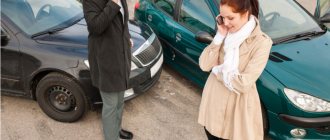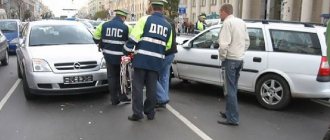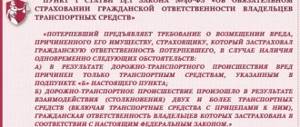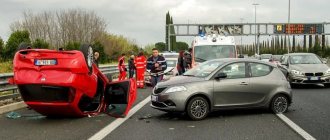Since 2003, all car owners are required to have an MTPL policy, which allows them to compensate for moral and material damage in the event of an accident. The maximum amount is 400 thousand rubles. The system works well on paper, but in practice, insurance companies constantly lower payments and sometimes refuse them completely. In this article, we will look at what an insured event is under compulsory motor liability insurance and how to behave in the event of an accident so as not to have problems with paying compensation.
OSAGO according to the law: legal framework
The operating principles of MTPL policies are formulated in Federal Law No. 40 of 2002, Federal Law No. 306 of 2007, Government Decree No. 263 of 2003, and Central Bank Regulation No. 431 of 2014. The law defines an insured event: a citizen with an MTPL policy, while driving a vehicle, caused harm to the health, life or property of others.
The situation is considered an insured event if three conditions are met:
- the culprit of the accident has a compulsory motor liability insurance policy;
- The accident occurred while the culprit’s car was in motion;
- the incident caused damage.
The fact of the incident must be officially recorded, otherwise the insurance company will refuse to pay.
Overview of main conditions
Insurance payments must be made at the expense of the insurance company and represent monetary compensation designed to reimburse the expenses of the injured person during an accident to improve his health and restore property.
The procedure for compensation is provided for by legislative acts in this area of the Federal Law “On compulsory insurance of civil liability of vehicle owners” and the Rules of OSAGO, as well as the basic norms of the Civil Code of the Russian Federation and the provisions of a separate agreement, which is concluded with each car owner.
Currently, the maximum amounts payable for an insured event under compulsory motor liability insurance in 2021 are 400,000 rubles in case of damage to property and 500,000 rubles if a person was injured.
Federal Law No. 40 “On Compulsory Motor Liability Insurance”
The conditions under which non-alternative direct compensation for damages is possible consist of the following provisions:
- Only two and no more vehicles are involved in the accident, the trailer is considered part of the vehicle and is subject to the requirement;
- both drivers are insured and have valid MTPL policies, and were also driving the car specified in the contract;
- damage was caused only to vehicles involved in the accident.
In all other situations, when harm is caused to the health of other persons, or three or more cars collide at once, you must contact the insurance company of the person responsible for the accident.
The MTPL Law provides for direct compensation for harm, which means the injured person has the opportunity to contact his or her insurance company.
When an event is not considered insured
- The damage was caused while driving a vehicle other than that specified in the MTPL.
- The damage was caused not by the machine, but by the load or trailer.
- The damage was caused during competitions or during training riding in specially designated areas.
- The damage occurred during loading or unloading.
- Only moral damage has been caused, and lost profits cannot be compensated.
- The damage was caused by force majeure circumstances.
- Objects of intangible or very high value (works of art, antiques, etc.) were damaged.
When an accident occurred in a yard or in a parking lot, the incident is considered an insured event under compulsory motor liability insurance if the car of the person responsible for the accident was in motion. When your car is damaged by a door when opening, scratched by a bag or keys, the insurance company will refuse to pay compensation.
Uninsured cases under compulsory motor liability insurance
The legislation establishes rules when the insurance company is not obliged to pay compensation, that is, non-insurance cases. Here is their list:
- The driver's policy does not indicate the car on which he caused damage, then the culprit driver pays compensation from his own pocket.
- The insurer does not pay moral compensation. Such issues are resolved by filing a claim in court, where a similar payment may be awarded, but in limited cases.
- The company is not obliged to pay for lost profits, but again, this issue can be resolved in court.
- The damage occurred during a test, training ride or sporting competition.
- The motorist harms the environment.
- Damage to the vehicle or cargo was intentionally caused by the driver himself.
- The vehicle was damaged due to loading or unloading.
- The insurance company does not pay compensation for damage to material assets.
- DBT occurred outside the Russian Federation.
- There are not enough documents or they were submitted late.
- SK went bankrupt.
- A medical examination showed that the driver was drunk at the time of the accident.
That's not all. There are situations in which the insurance company is also not obliged to pay anything:
- natural disasters, accidents;
- damage resulting from a nuclear attack;
- if any type of war begins: civil, world and others;
- damage was caused by popular unrest: rallies, uprisings, etc.
There will be no payment in the listed situations, regardless of the location of the incident, factors, and so on.
What if the accident happened in a parking lot?
Legislation will help you understand this issue, or more precisely, Article 1 of Law No. 40-FZ “On Compulsory Motor Liability Insurance”. It states that an insured event can be considered damage to the car or the lives of victims due to the use of the car. Now you need to pay attention to the last two words. The use of a car means its operation on roads and areas adjacent to them. Parking is classified as such in accordance with paragraph 1.2 of Article 1 of the Traffic Regulations. This means that even if an accident happened in a parking lot or parking lot, it should be considered an insured event.
If a car is damaged in a parking lot, for example, by an icicle falling from the roof, then this is not an insured event.
What should a driver do in the event of an insured event?
If your car has been damaged in an accident, you must take the following actions:
- Stop the car, turn on the hazard lights, put up an emergency sign, and if it’s dark, you need to put on a vest with reflective elements. Do not move the machine.
- If someone is injured, you need to call an ambulance.
- You must notify the traffic police about the accident (by landline - 02, by mobile - 112).
- If cars are blocking traffic, then you need to fix the position of the vehicles and then drive them away.
- Before the traffic police arrives, it is advisable to fill out an accident notification form.
- Record the details of witnesses, if any, and obtain their contacts for further proceedings.
- Record the accident on video or take detailed photographs.
- Take a copy of the resolution, protocol and certificate from the traffic police squad that will arrive at the scene of the incident.
This scenario is the only possible one if three or more cars were involved in the accident, the drivers did not agree on the issue of determining the culprit of the accident, one of the drivers refuses to sign the notification of the accident, or the estimated amount of damage is more than 100 thousand rubles.
But besides calling the traffic police, two more options are possible:
- You can report the incident to the traffic police, with their consent, do the paperwork yourself, and only then come to the department.
- You can issue a European protocol, but only if the following conditions are met: two cars were involved in the incident, only the car was damaged and no people were injured, both drivers have MTPL policies and there was no dispute between them regarding the nature of the damage to the cars.
There are a number of actions that should never be taken in the event of an accident. Firstly, flee the scene of the crime (there is only one exception - if it is necessary to take the victim to the hospital). Secondly, do not sign a confession of guilt and do not renounce your claims. All documents must be re-read carefully, and if you do not agree with any points, then report it. If the driver or passengers were seriously injured or the accident resulted in death, it is advisable to immediately call a lawyer to the scene of the accident.
How to fill out the documents yourself
If, with the permission of the traffic police, you have to file an accident yourself, you must fill out the documents. Mistakes cannot be made, otherwise the insurance company will refuse to pay:
- Notification of an accident. The front side of the document must be filled out jointly by all participants in the accident; if this is not possible, the reason must be indicated. Participation in filling out the document by a third party is not permitted. If drivers have no disagreements, then they can fill out one notice, and the insurer must be informed about this. If the drivers do not agree, each fills out the notice separately, indicating exact information about the accident, its participants, insurance and damage to the cars.
- Europrotocol. If documents are drawn up according to the European protocol, then both drivers fill out the notice, and all data must be certified by signatures. It must be taken into account that the damage paid under the European protocol does not exceed 100 thousand rubles, but the victim can demand a larger amount from the culprit through the court.
We collect documents for the insurance company
The victim must submit documents to the insurance company within the next five days. If the accident occurred in a remote area, the period can be increased to 15 days. It is necessary to collect the following package of documents:
- Statement about the occurrence of an insured event. It can be written in any form, but it must contain the following data: information about the victim and the culprit of the accident; detailed description of the insured event; description of the consequences of the incident; insurance policy data.
- Application for insurance payment.
- A copy of the passport certified by a notary.
- A power of attorney from the victim, if he himself cannot contact the insurer.
- Bank details of the victim.
- Certificate from the traffic police.
- A notification of an accident drawn up by those involved in the accident.
If the victim dies, his immediate relatives apply for insurance.
How to determine an insured event
To understand whether a company is obligated to pay compensation, you need to know the signs of insured events. No matter what the insurance company tells you, always double-check the information they give, since most often the insurer is not interested in paying out. An incident is considered an insured event when:
- Damage was caused to a vehicle insured under the contract.
- In an accident there are both the culprit and the victim. This is a must. The at-fault party will be subject to civil liability and the victim will receive compensation from the at-fault party's insurance company.
An example would be a situation where a driver was driving fast, but there was a traffic light ahead. He did not have time to brake and crashed into the car in front. The insurance company of the culprit is obliged to pay compensation to the victim. Another example: the driver of a large truck drove past a passenger car and carelessly hit it, causing damage. His insurance company will pay the cost of repairs to the owner of the car.
In case of an accident, OSAGO only insures liability to the other driver. The culprit is obliged to restore his own car at his own expense.
Actions of the insurance company
The insurance company must review the application, conduct an examination, draw up documents and pay compensation to the victim within 20 days.
Based on the results of the inspection, the insurance company issues a report to the victim, according to which he can verify the correctness of payments. The victim has the right to know all the information, including a description of the damage and its amount, therefore the refusal to issue a report is a violation.
By law, the insurance company must pay:
- compensation for car damage – up to 500 thousand rubles;
- compensation for damage to health – up to 400 thousand rubles;
- in the event of the death of the victim - up to 475 thousand rubles and 25 thousand for burial.
In 2021, it is planned to introduce a number of serious changes regarding compulsory motor liability insurance policies. Firstly, their cost will increase. Now it will be calculated taking into account five coefficients: territorial, age and driving experience of the driver, vehicle power, use of a trailer, and the circle of people allowed to drive. Secondly, in some regions a program for transmitting information about road accidents through the ERA-GLONASS system will be experimentally launched, and in this case the amount of insurance payment under the European protocol will be increased to 400 thousand rubles.
To receive payment under compulsory motor liability insurance, you must strictly comply with legal requirements, pay maximum attention to filling out documents, submit them to the insurer on time and wait for compensation. As a last resort, issues can be resolved through the court: if you entrust the defense to an experienced lawyer, then there is a high probability of a positive outcome of the case.










